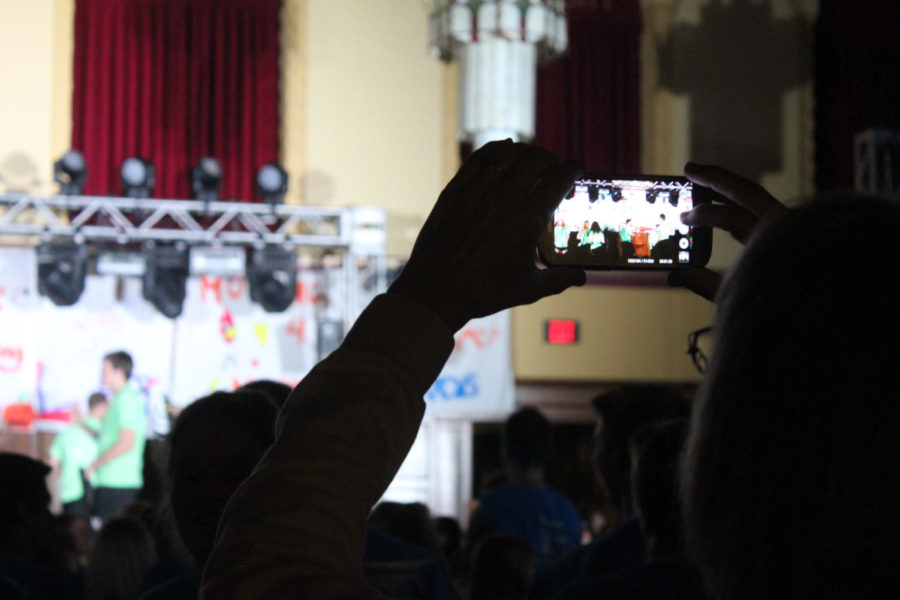Moran: Auto-correct humanity
Many people capture the action of Dance Marathon on their cell phones.
January 14, 2016
“But it’s no wonder in a world filled with iMac’s, iPads and iPhones/So many “i”’s, so many selfies, not enough “us”‘s and “we”’s/See, technology/Has made us more selfish and separate than ever/Cause while it claims to connect us, connection has gotten no better” – Prince Ea, “Can We Auto-Correct Humanity?”
Part way through my shift a few days ago, a family walked into where I work, and the first thing that caught my eye was a girl who looked to be no older than about 6 years old. The age wasn’t what caught my attention, it was the fact that she was glued to her smartphone rather than being engaged with her family. What was even more alarming was that her parents didn’t seem to view it as an issue.
About 15 minutes passed, and I noticed that the girl was still on her smartphone. To be honest, I was dumbfounded. Meanwhile, her father, mother and brother were playing cards at the table.
The part that really struck was when the mother took away her daughter’s phone about five minutes later. But as she put the phone on the other end of the table, the daughter leaned into her mother and whispered in her ear. The mother proceeded to give the phone back without question.
What is more disturbing: the fact that this child had a smartphone that seemed like a lifeline to her or that her parents were allowing their daughter to dictate when she got to use her phone?
It’s almost unnecessary to verbalize the fact that smartphones and other forms of technology have become a vital part of day-to-day life for most people. And as that short story demonstrates, children are not immune to its reach.
On average, 65 percent of children between the ages 8 and 18 own a smartphone in low-income families, and that percentage jumps to 93 percent in high-income families, according to a 2015 study by Common Sense Media. The same study found that tweens, ages 8-12, spend about six hours a day on social media, while teens, ages 13-18, spend upward of nine hours a day on social media.
I’ll be the first to admit that I’m not the best at putting down my electronics as much as I should. The current statistics, however, have reached the point of ridiculousness. When kids who are barely out of elementary school spend a fourth of their day on social media, a lot can be said about how children are being raised today.
You really can’t blame them because of the growing social media outlets available. A Pew Research Study found that 71 percent of teens between 13 and 17 years old use Facebook, 52 percent use Instagram and 41 percent use Snapchat. Twitter and Google+ both followed close behind. The lowest percentage was received by Tumblr, but it still boasted a double-digit download rate.
Tweens and young adults aren’t the only abusers of social media and technology usage. Another Pew Research Center survey studied the usage of social media by adults from 2005 to 2015. In 2005, 7 percent of American adults used social media, and 65 percent of American adults used social media in 2015, which proves that this isn’t just an adolescence issue.
There are a variety of reasons why they were using social media. I’m not saying it’s all bad because there are valid reasons to use all of the different types of social media as an adult. But the one thing that annoys me the most about social media and smartphone use is that I see people recording their kids, their friends, their events and anything they can with their phones.
Go to any event and you’ll see people glued to their phones, watching the event through their phone while they record it. You can’t honestly tell me the resolution on your phone is better than the real thing.
One of my favorite videos on YouTube ever is by Prince Ea titled “Can We Auto-Correct Humanity?” I found it ironic that I noticed this video while I was surfing the web, but it was eye-opening, and his lyrics served as the start of this column.
Long story short, our world has been consumed by technology, smartphones and social media, but we don’t need to conform to the social norm. There’s a world full of experiences right outside the door, and now is as good of a time as any to experience it.







